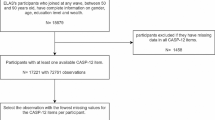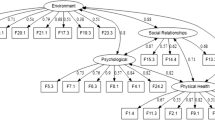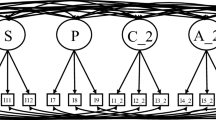Abstract
Purpose
Developing valid and reliable instruments that can be used across countries is necessary. The present study aimed to test the comparability of quality of life scores across three European countries (Finland, Poland, and Spain).
Method
Data from 9987 participants interviewed between 2011 and 2012 were employed, using nationally representative samples from the Collaborative Research on Ageing in Europe project. The WHOQOL-AGE questionnaire is a 13-item test and was employed to assess the quality of life in the three considered countries. First of all, two models (a bifactor model and a two-correlated factor model) were proposed and tested in each country by means of confirmatory factor models. Second, measurement invariance across the three countries was tested using multi-group confirmatory factor analysis for that model which showed the best fit. Finally, differences in latent mean scores across countries were analyzed.
Results
The results indicated that the bifactor model showed more satisfactory goodness-of-fit indices than the two-correlated factor model and that the WHOQOL-AGE questionnaire is a partially scalar invariant instrument (only two items do not meet scalar invariance). Quality of life scores were higher in Finland (considered as the reference category: mean = 0, SD = 1) than in Spain (mean = − 0.547, SD = 1.22) and Poland (mean = − 0.927, SD = 1.26).
Conclusions
Respondents from Finland, Poland, and Spain attribute the same meaning to the latent construct studied, and differences across countries can be due to actual differences in quality of life. According to the results, the comparability across the different considered samples is supported and the WHOQOL-AGE showed an adequate validity in terms of cross-country validation. Caution should be exercised with the two items which did not meet scalar invariance, as potential indicator of differential item functioning.

Similar content being viewed by others
References
World Health Organization. (1997). WHOQOL: Measuring quality of life. Geneva: World Health Organization.
The WHOQOL Group. (1995). The World Health Organization quality of life assessment (WHOQOL): Position paper from the World Health Organization. Social Science & Medicine, 41(10), 1403–1409.
The WHOQOL Group. (1996). What quality of life? World Health Organization quality of life assessment. World Health Forum, 17(4), 354–356.
Skevington, S. M. (2002). Advancing cross-cultural research on quality of life: observations drawn from the WHOQOL development. Quality of Life Research, 11(2), 135–144.
The WHOQOL Group. (1998). The World Health Organization quality of life assessment (WHOQOL): Development and general psychometric properties. Social Science & Medicine, 46(12), 1569–1585.
The WHOQOL Group (1998). Development of the World Health Organization WHOQOL-BREF quality of life assessment. Psychological Medicine, 28(03), 551–558.
Skevington, S. M., Lotfy, M., & O’Connell, K. A. (2004). The World Health Organization’s WHOQOL-BREF quality of life assessment: Psychometric properties and results of the international field trial. A report from the WHOQOL group. Quality of Life Research, 13(2), 299–310.
Power, M., Quinn, K., & Schmidt, S. (2005). Development of the WHOQOL-old module. Quality of Life Research, 14(10), 2197–2214.
Schmidt, S., Mühlan, H., & Power, M. (2006). The EUROHIS-QOL 8-item index: psychometric results of a cross-cultural field study. The European Journal of Public Health, 16(4), 420–428.
Fang, J., Power, M., Lin, Y., Zhang, J., Hao, Y., & Chatterji, S. (2012). Development of short versions for the WHOQOL-OLD module. The Gerontologist, 52(1), 66–78.
Leonardi, M., Chatterji, S., Koskinen, S., Ayuso-Mateos, J. L., Haro, J. M., Frisoni, G., et al. (2014). Determinants of health and disability in ageing population:the COURAGE in Europe project (Collaborative Research on Ageing in Europe). Clinical Psychology & Psychotherapy, 21(3), 193–198.
Caballero, F. F., Miret, M., Power, M., Chatterji, S., Tobiasz-Adamczyk, B., Koskinen, S., et al. (2013). Validation of an instrument to evaluate quality of life in the aging population: WHOQOL-AGE. Health and Quality of Life Outcomes, 11, 177.
Meredith, W. (1993). Measurement invariance, factor analysis, and factorial invariance. Pyschometrika, 58, 525–543.
Meredith, W., & Millsap, R. E. (1992). On the misuse of manifest variables in the detection of measurement bias. Psychometrika, 57(2), 289–311.
Miret, M., Caballero, F. F., Chatterji, S., Olaya, B., Tobiasz-Adamczyk, B., Koskinen, S., et al. (2014). Health and happiness: cross-sectional household surveys in Finland, Poland and Spain. Bulletin of the World Health Organization, 92(10), 716–725.
World Health Organization. (2013). Process of translation and adaptation of instruments. Geneva: World Health Organization. Retrieved from http://www.who.int/substance_abuse/research_tools/translation/en/.
Rey, J. J., Abad, F. J., Barrada, J. R., Garrido, L. E., & Ponsoda, V. (2014). The impact of ambiguous response categories on the factor structure of the GHQ–12. Psychological Assessment, 26(3), 1021–1030.
Schweizer, K., & Schreiner, M. (2010). Avoiding the effect of item wording by means of bipolar instead of unipolar items: An application to social optimism. European Journal of Personality, 24(2), 137–150.
Cohen, J. (1988). Statistical power analysis for the behavioral sciences. Hillsdale, NJ: Lawrence Erlbaum.
Fayers, P. M., Hand, D. J., Bjordal, K., & Groenvold, M. (1997). Causal indicators in quality of life research. Quality of Life Research, 6(5), 393–406.
Fayers, P. M., & Hand, D. J. (2002). Causal variables, indicator variables and measurement scales: an example from quality of life. Journal of the Royal Statistical Society: Series A (Statistics in Society), 165(2), 233–253.
Fayers, P. M., & Hand, D. J. (1997). Factor analysis, causal indicators and quality of life. Quality of Life Research, 6, 139–150.
Reise, S. P., Moore, T. M., & Haviland, M. G. (2010). Bifactor models and rotations: Exploring the extent to which multidimensional data yield univocal scale scores. Journal of Personality Assessment, 92, 544–559.
Reise, S. P., Morizot, J., & Hays, R. D. (2007). The role of the bifactor model in resolving dimensionality issues in health outcomes measures. Quality of Life Research, 16(1), 19–31.
Hox, J. J., Mass, C. J. M., & Brinkhuis, J. S. (2010). The effect of estimation method and sample size in multilevel structural equation modeling. Statistica Neerlandica, 64, 157–170.
Hu, L. T., & Bentler, P. M. (1999). Cutoff criteria for fit indices in covariance structure analysis: Conventional criteria versus new alternatives. Structural Equation Modeling, 6(1), 1–55.
Reise, S. P., Widaman, K. F., & Pugh, R. H. (1993). Confirmatory factor analysis and item response theory: Two approaches for exploring measurement invariance. Psychological Bulletin, 114(3), 552–566.
Akaike, H. (1974). A new look at the statistical model identification. IEEE Transactions On Automatic Control, 19, 716–723.
Gregorich, S. E. (2006). Do self-report instruments allow meaningful comparisons across diverse population groups? Testing measurement invariance using the confirmatory factor analysis framework. MedicalCare, 44(11 Suppl 3), S78–S94.
van de Schoot, R., Lugtig, P., & Hox, J. (2012). A checklist for testing measurement invariance. European Journal of Developmental Psychology, 9(4), 486–492.
Emerson, S. D., Guhn, M., & Gadermann, A. M. (2017). Measurement invariance of the Satisfaction with Life Scale: Reviewing three decades of research. Quality of Life Research, 26(9) 1–14.
Yoon, M., & Millsap, R. E. (2007). Detecting violations of factorial invariance using data-based specification searches: A Monte Carlo study. Structural Equation Modeling, 14(3), 435–463.
Cheung, G. W., & Rensvold, R. B. (2002). Evaluating goodness-of-fit indexes for testing measurement invariance. Structural Equation Modeling, 9(2), 233–255.
Byrne, B. M., Shavelson, R. J., & Muthén, B. (1989). Testing for the equivalence of factor covariance and mean structures: The issue of partial measurement invariance. Psychological Bulletin, 3(105), 456–466.
Cumming, G., & Finch, S. (2001). A primer on the understanding, use, and calculation of confidence intervals that are based on central and noncentral distributions. Educational and Psychological Measurement, 61(4), 532–574.
Kelley, K. (2007). Confidence intervals for standardized effect sizes: Theory, application, and implementation. Journal of Statistical Software, 20(8), 1–24.
Muthén, L. K., & Muthén, B. O. (2010). Mplus user’s guide: Statistical analysis with latent variables: User’s guide. Los Angeles: Muthén & Muthén.
StataCorp (2011). Stata statistical software: Release 12. College Station, TX: StataCorp LP.
Streiner, D. L. (2003). Being inconsistent about consistency: When coefficient alpha does and doesn’t matter. Journal of Personality Assessment, 80(3), 217–222.
United Nations (2013). Composition of macro geographical (continental) regions, geographical sub-regions, and selected economic and other groupings. Retrieved August 1, 2013, from http://unstats.un.org/unsd/methods/m49/m49regin.htm.
Eikemo, T. A., Huisman, M., Bambra, C., & Kunst, A. E. (2008). Health inequalities according to educational level in different welfare regimes: A comparison of 23 European countries. Sociology of health & Illness, 30(4), 565–582.
Abad, F. J., Sorrel, M. A., Román, F. J., & Colom, R. (2016). The relationships between WAIS-IV factor index scores and educational level: A bifactor model approach. Psychological Assessment, 28(8), 987–1000.
Mellor-Marsá, B., Miret, M., Abad, F. J., Chatterji, S., Olaya, B., Tobiasz-Adamczyk, B., et al. (2016). Measurement invariance of the day reconstruction method: Results from the COURAGE in Europe project. Journal of Happiness Studies, 17(5), 1769–1787.
Sass, D. A., Schmitt, T. A., & Marsh, H. W. (2014). Evaluating model fit with ordered categorical data within a measurement invariance framework: A comparison of estimators. Structural Equation Modeling: A Multidisciplinary Journal, 21(2), 167–180.
Millsap, R. E. (2011). Statistical Approaches to Measurement Invariance. New York: Routledge.
Xia, Y. (2016). Investigating the chi-square-based model-fit indexes for WLSMV and ULSMV estimators. Doctoral dissertation, The Florida State University.
Lara, E., Koyanagi, A., Caballero, F., Domènech-Abella, J., Miret, M., Olaya, B., et al. (2017). Cognitive reserve is associated with quality of life: A population-based study. Experimental Gerontology, 87, 67–73.
Raggi, A., Corso, B., Minicuci, N., Quintas, R., Sattin, D., De Torres, L., et al. (2016). Determinants of quality of life in ageing populations: Results from a cross-sectional study in Finland, Poland and Spain. PLoS ONE, 11(7), e0159293.
Garin, N., Olaya, B., Moneta, M. V., Miret, M., Lobo, A., Ayuso-Mateos, J. L., & Haro, J. M. (2014). Impact of multimorbidity on disability and quality of life in the Spanish older population. PLoS ONE, 9(11), e111498.
Snell, D. L., Siegert, R. J., Surgenor, L. J., Dunn, J. A., & Hooper, G. J. (2016). Evaluating quality of life outcomes following joint replacement: Psychometric evaluation of a short form of the WHOQOL-Bref. Quality of Life Research, 25(1), 51–61.
Torisson, G., Stavenow, L., Minthon, L., & Londos, E. (2016). Reliability, validity and clinical correlates of the Quality of Life in Alzheimer’s disease (QoL-AD) scale in medical inpatients. Health and Quality of Life Outcomes, 14, 90.
Acknowledgements
The present research has been funded by the Seventh Framework Programme of the European Commission (FP7/2007-2013) under Grant Agreement Number 223071 (COURAGE in Europe), by the Instituto de Salud Carlos III-FIS research Grant Numbers PS09/00295 and PS09/01845, by the Spanish Ministry of Science and Innovation’s ACI-Promociona (ACI2009-1010), and the Mental Health and Disability Instrument Library Platform (CIBERSAM). The study was also supported by the Centro de Investigación Biomédica en Red de Salud Mental (CIBERSAM), Instituto de Salud Carlos III. D.S. is grateful to the Universidad Autónoma de Madrid for the doctoral fellowship (Reference No. FPI-UAM2015). F.J.A. is grateful to the Ministerio de Economia y Competitividad (Grant PSI2013-44300-P). All authors gratefully acknowledge the input of Prof. Mick Power during the process of selecting the WHOQOL-AGE items.
Author information
Authors and Affiliations
Corresponding author
Rights and permissions
About this article
Cite this article
Santos, D., Abad, F.J., Miret, M. et al. Measurement invariance of the WHOQOL-AGE questionnaire across three European countries. Qual Life Res 27, 1015–1025 (2018). https://doi.org/10.1007/s11136-017-1737-8
Accepted:
Published:
Issue Date:
DOI: https://doi.org/10.1007/s11136-017-1737-8




